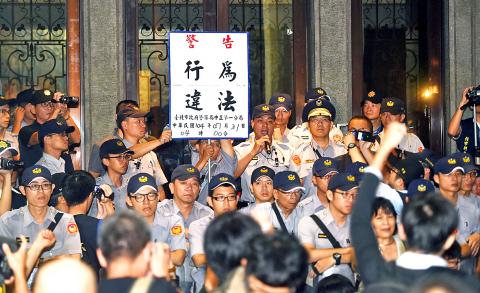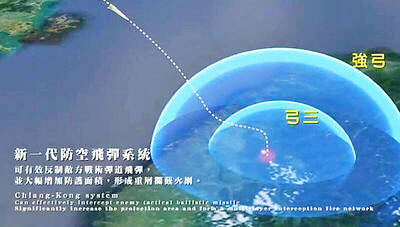The Taipei City Government has directed police to take a “soft stance” when facing protesting students, who vaulted the barricades set up around the Ministry of Education early yesterday morning, resulting in a standoff between police stationed around the main building and the protesting students, who have been occupying the ministry’s plaza.
At press time last night, the sit-in was ongoing. Their bringing down the barbed barricade was “monitored” closely, but not stopped by police officers from Zhongzheng First Precinct at about 1:30am yesterday.
That the restrained attitude was taken due to the city government’s orders was confirmed by Taipei Mayor Ko Wen-je (柯文哲) yesterday, who said the city government directed the police to take “a soft approach,” as both the police and the students are human beings who were not able to sleep the night before and the real problem should be solved by the ministry.

Photo: Fang Pin-chao, Taipei Times
The police were seen guarding the entrances to the ministry’s main building and holding up a banner that said the protesters’ actions have breached the law at least four times throughout the night, but they did not evict or arrest the students.
Another new measure taken by the city government was the deployment of “media liaison” officers.
At least three people wearing pink and partly fluorescent vests with “media liaison of the Taipei City Government Police Department” imprinted on them were seen yesterday outside the ministry building.
The move was taken by the city government after the arrests of three reporters and dozens of students on Thursday night last week and Ko’s subsequent apology for police failing to follow “standard operating procedures.”
One of the officers said that deploying media liaison officers to large gatherings that are prone to violations of the law is not new, but the officers were not as easily identified before.
When questioned by reporters about the deployment, the number of police officers present and whether the students would be evicted, the officers were unable to provide answers.

LIMITS: While China increases military pressure on Taiwan and expands its use of cognitive warfare, it is unwilling to target tech supply chains, the report said US and Taiwan military officials have warned that the Chinese People’s Liberation Army (PLA) could implement a blockade within “a matter of hours” and need only “minimal conversion time” prior to an attack on Taiwan, a report released on Tuesday by the US Senate’s China Economic and Security Review Commission said. “While there is no indication that China is planning an imminent attack, the United States and its allies and partners can no longer assume that a Taiwan contingency is a distant possibility for which they would have ample time to prepare,” it said. The commission made the comments in its annual

DETERMINATION: Beijing’s actions toward Tokyo have drawn international attention, but would likely bolster regional coordination and defense networks, the report said Japanese Prime Minister Sanae Takaichi’s administration is likely to prioritize security reforms and deterrence in the face of recent “hybrid” threats from China, the National Security Bureau (NSB) said. The bureau made the assessment in a written report to the Legislative Yuan ahead of an oral report and questions-and-answers session at the legislature’s Foreign Affairs and National Defense Committee tomorrow. The key points of Japan’s security reforms would be to reinforce security cooperation with the US, including enhancing defense deployment in the first island chain, pushing forward the integrated command and operations of the Japan Self-Defense Forces and US Forces Japan, as

‘TROUBLEMAKER’: Most countries believe that it is China — rather than Taiwan — that is undermining regional peace and stability with its coercive tactics, the president said China should restrain itself and refrain from being a troublemaker that sabotages peace and stability in the Indo-Pacific region, President William Lai (賴清德) said yesterday. Lai made the remarks after China Coast Guard vessels sailed into disputed waters off the Senkaku Islands — known as the Diaoyutai Islands (釣魚台) in Taiwan — following a remark Japanese Prime Minister Sanae Takaichi made regarding Taiwan. Takaichi during a parliamentary session on Nov. 7 said that a “Taiwan contingency” involving a Chinese naval blockade could qualify as a “survival-threatening situation” for Japan, and trigger Tokyo’s deployment of its military for defense. Asked about the escalating tensions

INTERCEPTION: The 30km test ceiling shows that the CSIST is capable of producing missiles that could stop inbound missiles as they re-enter the atmosphere Recent missile tests by the Chungshan Institute of Science and Technology (CSIST) show that Taiwan’s missiles are capable of intercepting ballistic missiles as they re-enter the atmosphere and pose a significant deterrent to Chinese missile threats, former Hsiung Feng III missile development project chief engineer Chang Cheng (張誠) said yesterday. The military-affiliated institute has been conducting missile tests, believed to be related to Project Chiang Kung (強弓) at Pingtung County’s Jiupeng Military Base, with many tests deviating from past practices of setting restriction zones at “unlimited” and instead clearly stating a 30.48km range, Chang said. “Unlimited” restrictions zones for missile tests is